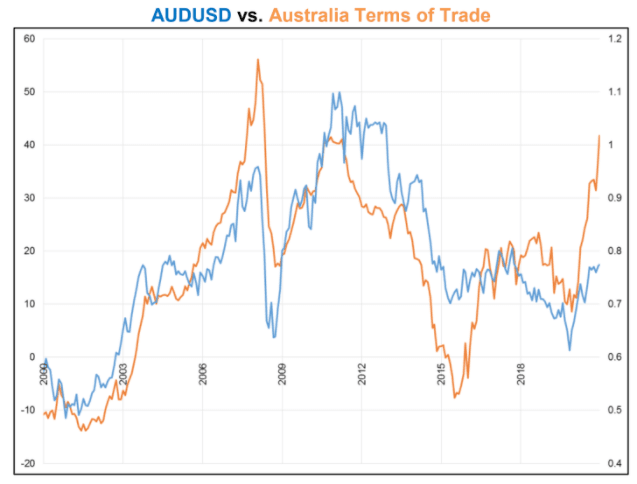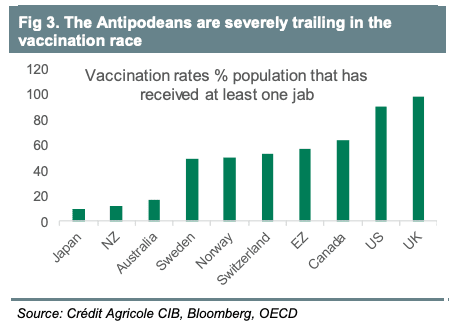Australian Dollar: Crédit Agricole says Low Vaccination Rate is Weighing
- Written by: Gary Howes

Above: Melbourne has recently seen an outbreak of Covid-19 cases. Image © Adobe Images.
- GBP/AUD reference rates at publication:
- Spot: 1.8254
- Bank transfer rates (indicative guide): 1.7615-1.7743
- Money transfer specialist rates (indicative): 1.8090-1.8126
- More information on securing specialist rates, here
- Set up an exchange rate alert, here
Australia's slow vaccination rollout leaves the country vulnerable to further cycles of economically damaging lockdowns, and this could be one reason why the Australian Dollar is underperforming shows a new analysis.
According to research from Crédit Agricole the Australian Dollar is a relative 'underperformer' on global currency markets relative to where the underlying fundamentals suggest it should be.
Valentin Marinov, Head of G10 FX Strategy at Crédit Agricole, says low vaccination rates in Australia helps explain "some of AUD/USD’s undervaluation."
"Cyclical currencies are all benefitting from the re-opening of the global economy and the recovery in global trade. But some of these currencies are benefitting more than others depending on factors such as relative commodity export prices, trading partner growth, monetary policy and even vaccination rates," says Marinov in a recently published research briefing.
Above: Australian 'undervaluation' relative to commodity prices. What explains the gap?
The theme of Australia's slow vaccination rate is one that has been picked up by other analysts.
We reported on May 24 that Aussie lender Westpac suspected some element of the Australian Dollar's underperformance could be linked to relative vaccination rates.
"Elevated commodity prices underpin bullish Australian forecasts but perhaps the currency is being held back by Australia’s low Covid-19 vaccination rate and flareup of new cases in Asia. Europe now looks more promising in this regard," said Richard Franulovich, Head of FX Strategy at Westpac in Sydney.
The 'vaccine trade' has been a notable theme of 2021 as countries race to vaccinate their populations with a view to unlocking their economies on a sustainable basis.
The Pound was a notable winner of this trade in the first quarter of 2021 as the UK were quick to start vaccinating.
Analysts say the trade is still relevant, particularly for those countries that are laggards.
"We expect vaccination rates to remain an important factor for some G10 exchange rates until there is more convergence in relative vaccination rates. For Australia and NZ, this catch up and convergence is not likely until late 2021/early 2022," says Marinov.
Secure a retail exchange rate that is between 3-5% stronger than offered by leading banks, learn more.
"Vaccination rates remain significant drivers for AUD/USD, EUR/NOK and EUR/SEK exchange rates. Indeed, the large distance between Australia and the US’s vaccination rate is weighing significantly on AUD/USD, even after accounting for Australia’s very low infection rate," says Marinov.
"The fact that Canada’s vaccination rate is less behind that of the US means that this lower vaccination rate is having very little impact on the USD/CAD exchange rate. The trailing vaccination rate in Scandinavian countries vs the Eurozone is also weighing on their currencies relative to the EUR," he adds.
All countries will have to inoculate a significant portion of their population in order to achieve a vaccine-driven herd immunity, which scientists say is the only feasible sustainable route of the pandemic.
That threshold to achieving such a herd immunity is however only raised higher by more virulent strains of Covid-19, as the UK is discovering with the Indian variant.
Australia and New Zealand face further cycles of damaging lockdowns in the future as they maintain a 'zero covid' policy, highlighted by the latest lockdowns in Melbourne.
Therefore the longer Australia takes in rolling out vaccinations, the longer it will take to return to normal and attain full economic capacity.
Until the economy reaches its full capacity - which requires open borders - the Reserve Bank of Australia (RBA) is likely to maintain a soft approach to interest rates which has significant implications for Australian Dollar exchange rates.
{wbamp-hide start} {wbamp-hide end}{wbamp-show start}{wbamp-show end}
The Australian Dollar's failure to lift alongside surging commodity prices - which have reached record highs already in 2021 - has been one of the more interesting aspects of the currency markets covered by Pound Sterling Live of late.
An article we published recently notes the low interest rates on offer at the RBA appear to be a critical element of this undervaluation dynamic, with one trader noting: "it’s not terms of trade that drives AUD but the impact terms of trade has on rates. In the past, ToT swings have led to interest rate swings. This time, not so much".
With the Australian economy operating at below potential owing to the global health crisis, interest rates at the RBA are likely to stay at record low levels until at least 2023.
"The RBA and the Riksbank are the least hawkish of the G10 cyclical currency central banks, which leaves the AUD and SEK trailing," says Marinov.
But, we reported on Monday that analysts at ANZ Bank are of the view the RBA will at their July meeting announce a 'soft taper' to the quantitative easing programme, a necessary step on the road towards raising interest rates.
Such a shift could be a material one for the RBA, which is considered one of the most 'dovish' of the major central banks.
It could therefore represent a supportive development for those in the market looking out for a stronger Australian Dollar.
{wbamp-hide start} {wbamp-hide end}{wbamp-show start}{wbamp-show end}






